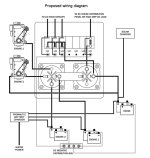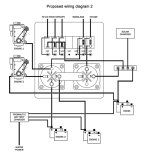thataway":1u4c05sx said:
The second diagram is not going to work--at least well.
The only work-around to use the current wiring is to keep both switches in the Combine position at all times.
Not exactly my definition of "works well" either.
thataway":1u4c05sx said:
Why are you not using the Aux charging circuit of the engines?
Dealer didn't include the aux harnesses with the engines.
I may end up purchasing one in the future, but for the time being I'll fix and use the gadgets that it came with.
We still have to purchase some railings, radar arch, radar, VHF antennae, and 2nd chartplotter, so I'd rather shift the boat budget there first.
thataway":1u4c05sx said:
I would have a start battery for each engine. Then the aux charging circuit to the house batteries.
Too many complicated switches--and VSR... Which are great if you don't have the aux charging circuits.
Battery charger: Pronautic 1220 output: one to each of engine start and one to the house bank. That charger is "smart" and will send proper charge to each of the batteries as needed.
Yes, between one aux charging harness and the Pronautic, all batteries would charge properly on their own leads without needing the ACRs.
Shame that wasn't considered by the people who put it together.
I still may end up getting the aux harnesses, and eliminating the ACRs to simplify the wiring when we get around to discussing adding the solar and another bank.
For right now, I'm just trying to find out where the proper points are for connecting the leads from the Pronautic to the original Blue Seas diagram.
Btw, which AGM golf cart bats did you buy?


